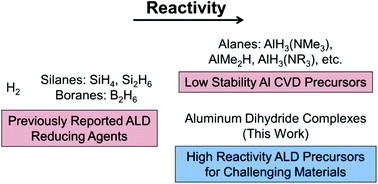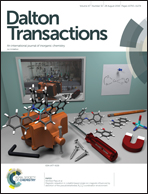Aluminum dihydride complexes and their unexpected application in atomic layer deposition of titanium carbonitride films†
Abstract
Aluminum dihydride complexes containing amido-amine ligands were synthesized and evaluated as potential reducing precursors for thermal atomic layer deposition (ALD). Highly volatile monomeric complexes AlH2(tBuNCH2CH2NMe2) and AlH2(tBuNCH2CH2NC4H8) are more thermally stable than common Al hydride thin film precursors such as AlH3(NMe3). ALD film growth experiments using TiCl4 and AlH2(tBuNCH2CH2NMe2) produced titanium carbonitride films with a high growth rate of 1.6–2.0 Å per cycle and resistivities around 600 μΩ cm within a very wide ALD window of 220–400 °C. Importantly, film growth proceeded via self-limited surface reactions, which is the hallmark of an ALD process. Root mean square surface roughness was only 1.3% of the film thickness at 300 °C by atomic force microscopy. The films were polycrystalline with low intensity, broad reflections corresponding to the cubic TiN/TiC phase according to grazing incidence X-ray diffraction. Film composition by X-ray photoelectron spectroscopy was approximately TiC0.8N0.5 at 300 °C with small amounts of Al (6 at%), Cl (4 at%) and O (4 at%) impurities. Remarkably, self-limited growth and low Al content was observed in films deposited well above the solid-state thermal decomposition point of AlH2(tBuNCH2CH2NMe2), which is ca. 185 °C. Similar growth rates, resistivities, and film compositions were observed in ALD film growth trials using AlH2(tBuNCH2CH2NC4H8).

- This article is part of the themed collection: Spotlight Collection: Atomic and Molecular Layer Deposition


 Please wait while we load your content...
Please wait while we load your content...